Blackburn and Darwen WwTWs (2017)
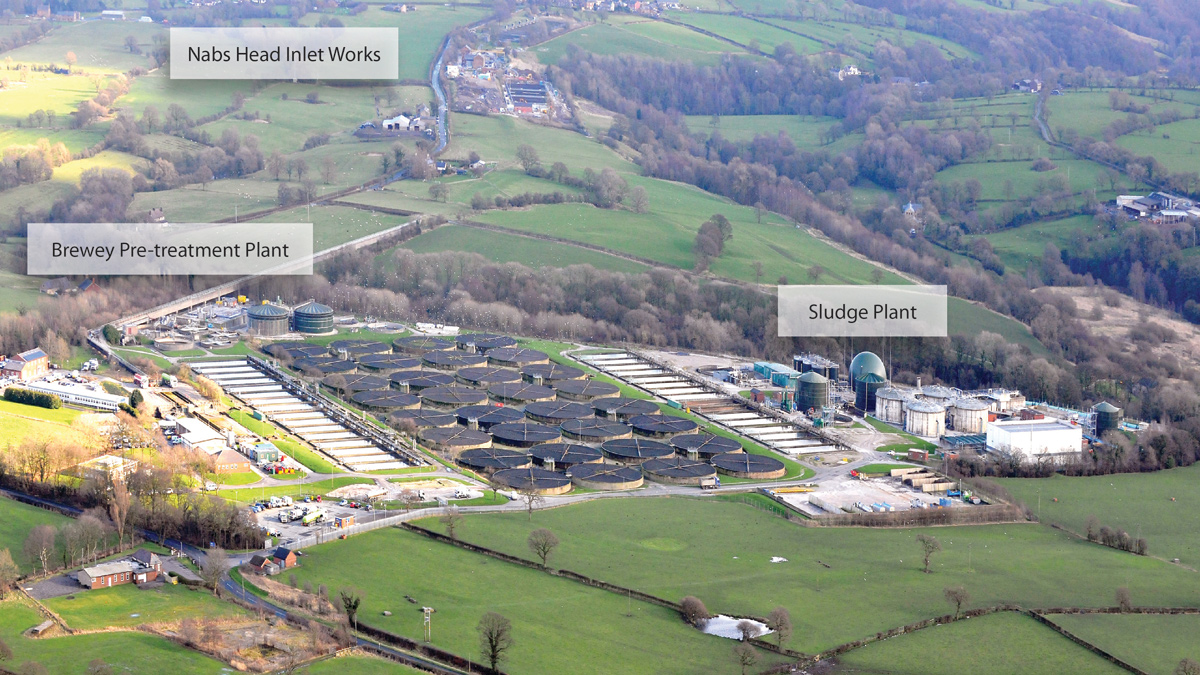
Blackburn WwTW - Courtesy of Airviews Photography & Co
Blackburn and Darwen WwTWs are two of United Utilities’ major treatment works and are located near the former mill town of Blackburn, Lancashire. The Blackburn and Darwen WwTW Integrated Solution (BDIS) project combines new river water quality and bathing water drivers at these two works into a single integrated project. The integrated approach will give significant savings to both capital and operational expenditures and replace existing aging assets. The backbone of the solution is to close Darwen WwTW, transfer flow 12km to Blackburn WwTW and rebuild Blackburn WwTW to treat the combined flows to a higher quality. At both sites, additional storm storage will be built to reduce storm discharge. The project will be commissioned in 2021.
Background and need
Blackburn WwTW is United Utilities’ sixth largest with a population equivalent of 250,000 while Darwen WwTW has a population equivalent of 31,000. They were both built in the 1960s and consist of an inlet works, storm storage, primary settlement tanks, trickling filters and final tanks. In addition, Blackburn WwTW has tertiary BAFF and UV treatment and a dedicated pre-treatment plant for the adjacent AB Inbev Brewery. Blackburn WwTW is also a sludge processing plant for the local area with sludge thickening, enhanced enzymic hydrolysis pre-treatment, digestion and CHP engines.
Both Blackburn and Darwen WwTWs discharge final and storm effluent to watercourses that are tributaries of the River Darwen, feeding into the River Ribble and ultimately impacting on the bathing waters of the Fylde coast. Both have AMP6 and AMP7 requirements to improve the river and bathing water quality. Also, both are ageing works with most assets requiring significant maintenance or replacement over the next 3 AMPs. It was identified during PR14 studies that both WwTWs had similar improvement requirements which are summarised in the table below.

Improvement Requirements of Blackburn WwTW and Darwen WwTW
Original solutions
Initially, individual solutions for both the Blackburn and Darwen sites were developed independently of each other. The proposed solutions highlighted both WwTWs would require activated sludge plants to achieve the proposed discharge consents, which were tightening considerably to around 25% of the current value for BOD and ammonia.
In addition, significant amounts of storm storage, 120,000m3 at Blackburn and 12,000m3 at Darwen, would be required to reduce storm spills to meet the river and bathing water quality standards. The PR14 team soon realised that Darwen WwTW was located adjacent to the Blackburn catchment so identified an opportunity to abandon the ageing and confined Darwen WwTW and transfer flows to Blackburn WwTW via a 6.8km pumped and gravity main. However, it soon became evident that providing a total of 140,000m3 of storm storage at Blackburn WwTW would require the works to operate at FTFT most of the time to allow the storm tanks to be emptied. Prolonged operation at FTFT would make it difficult to take process units off line for maintenance, which in turn would put compliance at risk. Therefore, the idea to increase FTFT was proposed, which negated the need to build additional storage.
Nine options were appraised which looked at a mixture of treatment or transfer and providing additional treatment capacity or storm storage at Blackburn WwTW. The lowest whole life cost solution was to build a single new treatment plant at Blackburn WwTW to cater for increased flows with an FTFT of 4DWF, and additional storm storage of 12,000m3 at Darwen WwTW only.
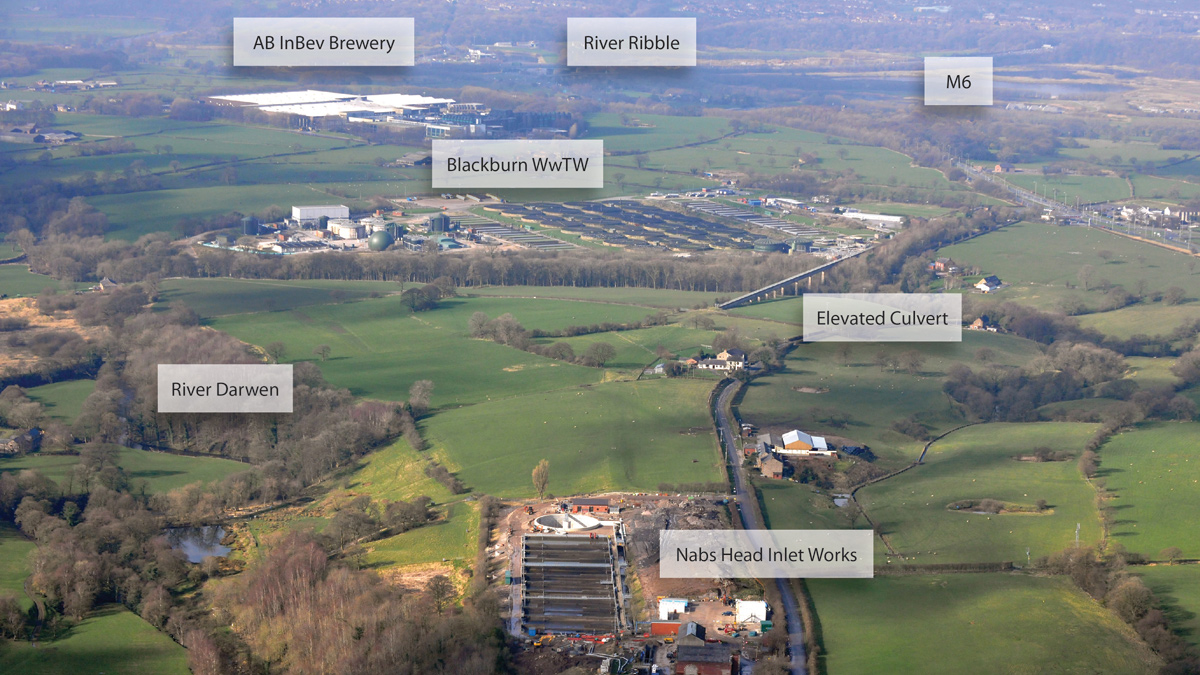
Blackburn WwTW – Courtesy of Airviews Photography & Co
Concept Phase: Development of high level solution
The BDIS project was born in October 2013, when finance was approved to look at an integrated solution instead of the two individual solutions. It was initially progressed as an AMP6 Transitional Investment project, although it soon became evident that due to its complexity the work would span AMPs 5, 6 and 7.
An integrated team was formed bringing together representatives from Engineering, Programme Services, Commercial and Operations, the majority being co-located in a single office to promote efficient delivery. The team’s first tasks involved ensuring all requirement were understood, by confirming details of the drivers and investigating the existing assets, and reviewing the options originally proposed. These elements were then combined to propose a new high-level solution enabling the in-house estimating team to produce cost estimates.
Investigation of the quality drivers identified a change to the consenting method for the final effluent UV plant. As this was to be extended a new Environmental Permit would be issued with a validated applied dose requirement instead of the current measured applied dose of 35Mj/cm2. This identified the requirement for a suite of quality sampling to be carried out to inform the permit.
A review of Blackburn WwTW identified several additional maintenance requirements that had not been fully investigated at PR14. This included the requirement for new screening and grit removal on the pumped flows from a small, local catchment that connects downstream of the inlet works.
Also, due to its age the brewery pre-treatment plant has major maintenance issues. As the trade effluent from the brewery can provide up to 33% of the COD load arriving at the works the requirement for a new pre-treatment plant was debated. However, to maximise potential treatment options, it was determined that there should be no specific future requirement for this.
A review of the existing proposal identified some omissions and technical challenges. One area in particular was the route of the 6.8km rising main. This had to gain about 100m elevation before crossing a motorway, canal, railway, river and a SSSI. A review undertaken by the project team identified an alternative and shorter route of 1.6km by utilising a sewer that was partially installed when Darwen WwTW was potentially being closed as part of the M65 construction in 1981. This brought the additional benefit that it enabled both FTFT and all storm returns to be passed into the Blackburn catchment under gravity. This would significantly reduce both construction and operational costs.
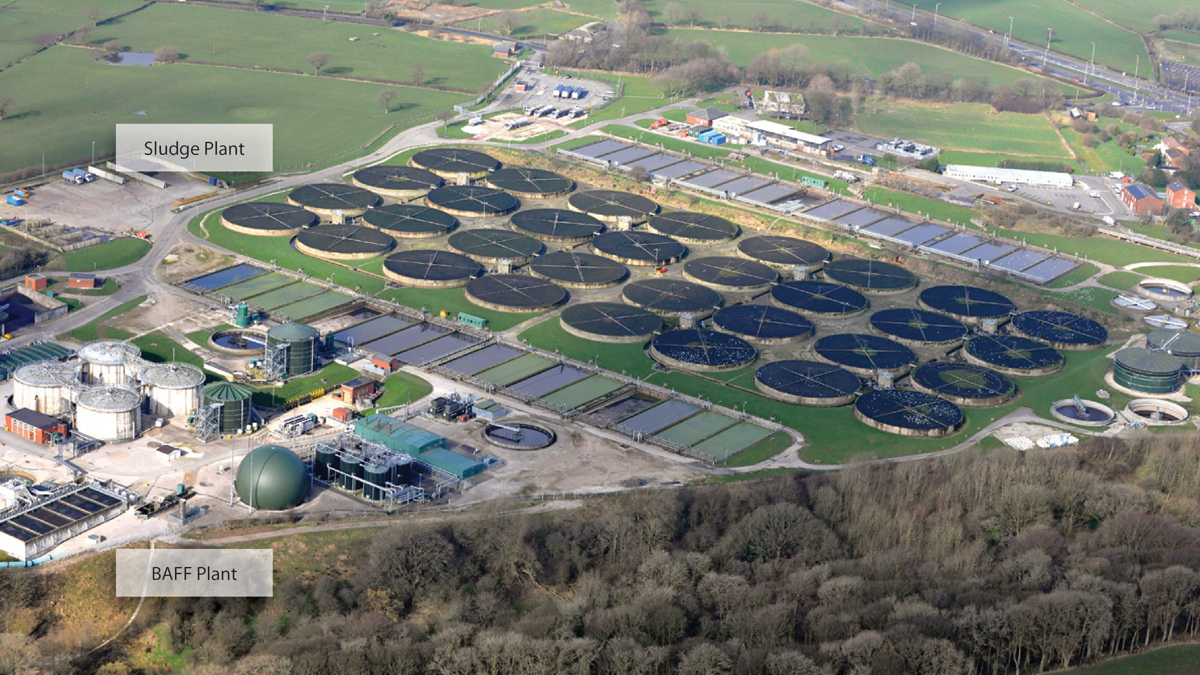
Blackburn WwTW – Courtesy of Airviews Photography & Co
Also, when looking at options the PR14 team had considered storm storage and increased FTFT as mutually exclusive when the optimal solution would likely utilise both elements. Therefore, the wastewater network and river modelling team carried out modelling to determine optimum storm storage volumes and FTFT figures at both locations to meet the river and bathing water quality targets. It quickly became apparent that some additional storm storage would be required at Blackburn WwTW to reduce the potential variance in flows going through the works.
Following re-verification of the network model, to include climate change and population growth to the 2036 design horizon, the required storm storage volume increased to 50,000m3 at Blackburn WwTW and increased from 12,000m3 to 15,000m3 at Darwen WwTW.
The review also identified the current sludge treatment facility at Blackburn was neither large nor reliable enough to meet future needs and therefore needed expanding and upgrading. Furthermore, a regional strategic capacity review proposed that Blackburn should become a strategic sludge processing site. This increased the sludge throughput allowance to 35,000tdspa from the original 21,000tdspa.
All the above were combined into the high-level solution and saw the estimated cost of the scheme increase by approximately £25m, more than offset by savings elsewhere on the sludge programme.
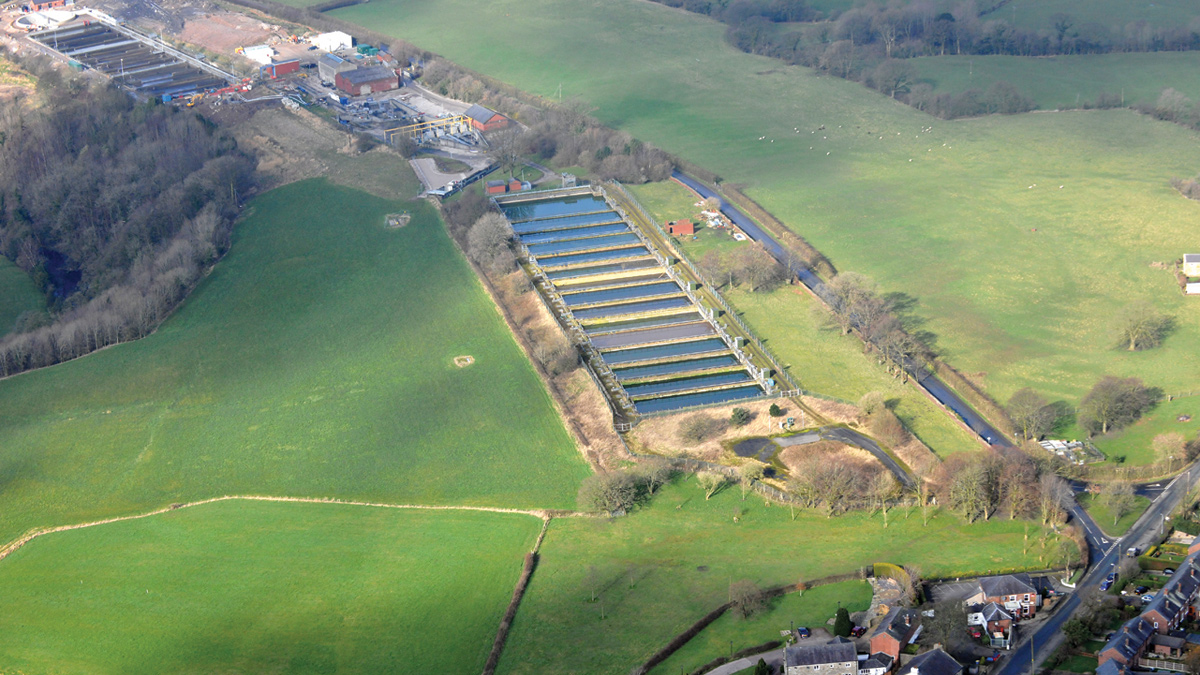
Nabs Head Inlet Works – Courtesy of Airviews Photography & Co
Definition Phase: Preparation of tender documentation to contract award
To reduce risks associated with unknown conditions and missing information on the project a significant data gathering exercise was initiated. This exercise:
- Unearthed around 530 relevant drawings of the existing works and about 250 documents providing pre-construction information.
- Included a series of targeted geotechnical site investigation works to provide ground information on areas of the proposed construction previously un-surveyed.
- Involved undertaking ecological surveys which confirmed the presence of great crested newts, badgers, giant hogweed, otters and rare barbastelle bats.
- Involved updating the existing topographical plan of the sites to capture construction undertaken during AMP4 and AMP5.
- Included a survey of the 30m high elevated concrete box culvert, which connects Blackburn inlet works to the main site and was identified as a critical asset, to ensure its structural integrity and define its hydraulic capacity.
- Involved holding three requirements workshops with operational staff to ensure buy-in to the project and identify any project constraints.
Environmental impact assessment
Due to the size and nature of the project a screening opinion for an Environmental Impact Assessment (EIA) under the Town and Country Planning (EIA) Regulations 2011 was sought. The local authority confirmed an EIA would be required for the Blackburn WwTW part of the project only. However, this did not align with the United Utilities’ understanding of the local area so an appeal was lodged with the Secretary of State’s office.
This appeal was successful leading to a time saving of approximately 12 months and enabling earlier mobilisation for construction.

(left) Blackburn WwTW, primary settlement tanks, with brewery pre-treatment plant in background and (right) Blackburn WwTW, trickling filters, with sludge treatment – plant in background – Courtesy of United Utilities
Commercial
The procurement route chosen for the project was competitively tendered under a design and build contract using IChemE Red Book (lump sum). The original OJEU notice, which was issued in September 2014, received only two responses, perhaps indicating the market conditions at the time. In an attempt to encourage greater participation, the contract was changed to NEC3 ECC Option C (target cost) and the OJEU reissued in July 2015.
This initially received three responses but due to existing workload commitments one party withdrew prior to the tender issue in November 2015.
Tenders were returned in June 2016 and appraisals undertaken which showed both to be technically compliant but with costs significantly above the company business plan (CBP) allowance. In response to the affordability challenge, risk and value exercises were undertaken internally and with the two tenderers separately.
This exposed several opportunities that reduced the capital cost without significantly impacting on the ability to achieve the principal drivers The opportunities were incorporated into a revised Employers Works Information which was reissued in November 2016.

Darwen WwTW Trickling Filters – Courtesy of United Utilities
Scope of work summary
- Blackburn WwTW
- 35,000m3 of storm storage.
- 180,000m3 12-cell SBR, 8 (No.) disc filters and UV plant, all using technology from Xylem Water Solutions.
- 33,000 tdspa sludge processing centre.
- Darwen WwTW
- 11,500m3 of storm storage.
- Darwen pipeline
- 1,700m of 750mm diameter.
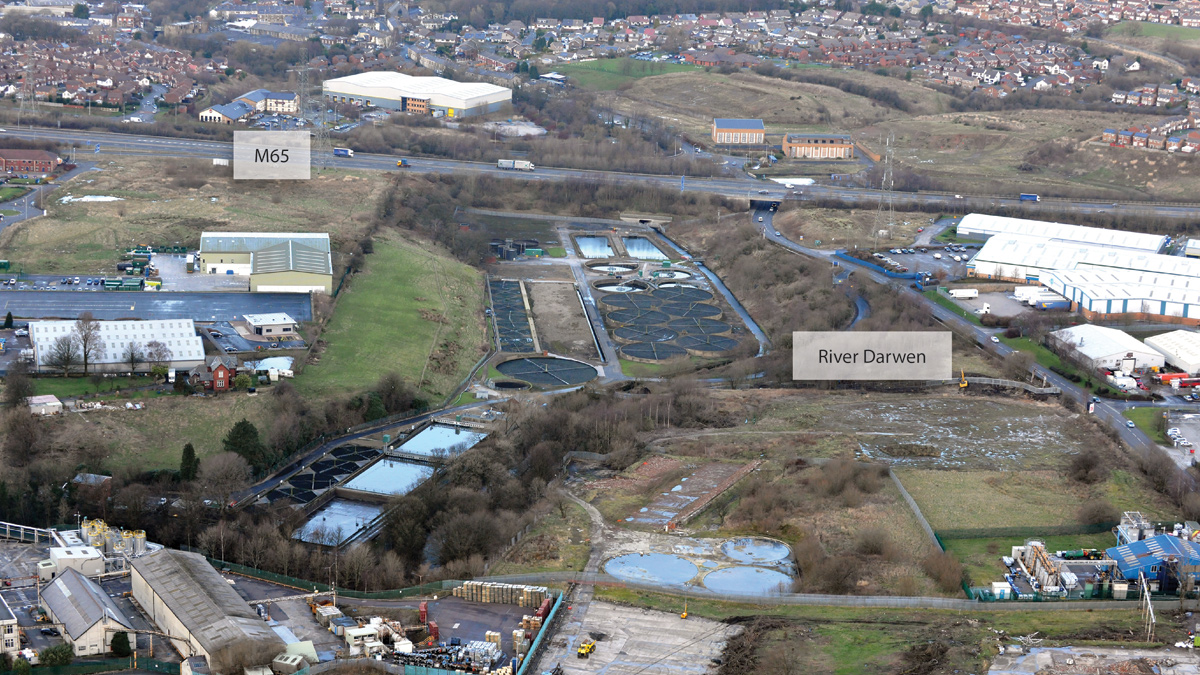
Darwen WwTW – Courtesy of Airviews Photography & Co
Conclusion
At the time of writing (June 2017), GCM, (a joint venture of Galliford Try, Costain and Mott MacDonald) is carrying out the initial design, which is scheduled to be significantly complete by March 2018. Construction will commence in November 2017, with excavation for the SBRs and will be fully complete in 2022. It is anticipated that United Utilities will provide an article highlighting the detail design and construction of this project in future issues of UK Water Projects.
Updates
Two subsequent articles have been published; the Blackburn and Darwen WwTWs (2018) article and Blackburn and Darwen WwTWs (2019).









